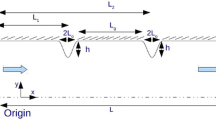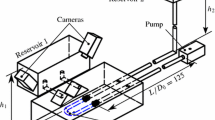Abstract
Steady flow and physiological pulsatile flow in a rigid 180° curved tube are investigated using particle image velocimetry. A non-Newtonian blood-analog fluid is used, and in-plane primary and secondary velocity fields are measured. A vortex detection scheme (d 2-method) is applied to distinguish vortical structures. In the pulsatile flow case, four different vortex types are observed in secondary flow: deformed-Dean, Dean, Wall and Lyne vortices. Investigation of secondary flow in multiple cross sections suggests the existence of vortex tubes. These structures split and merge over time during the deceleration phase and in space as flow progresses along the 180° curved tube. The primary velocity data for steady flow conditions reveal additional vortices rotating in a direction opposite to Dean vortices—similar to structures observed in pulsatile flow—if the Dean number is sufficiently high.














Similar content being viewed by others
Notes
This is the only figure in the present study showing the Newtonian fluid results.
Here the terminology “Lyne vortex” refers to the deformed-Lyne vortex based on Sudo et al. (1992).
References
Abate J, Whitt W (2006) A unified framework for numerically inverting Laplace transforms. Informs J Comput 18:408–421
Berger SA, Talbot L, Yao L-S (1983) Flow in curved pipes. Annu Rev Fluid Mech 15:461–512
Bertelsen AF (1975) An experimental investigation of low Reynolds number secondary streaming effects associated with an oscillating viscous flow in a curved pipe. J Fluid Mech 70:519–527
Boiron O, Deplano V, Pelissier R (2007) Experimental and numerical studies on the starting effect on the secondary flow in a bend. J Fluid Mech 574:109–129. doi:10.1017/S0022112006004149
Bulusu KV, Plesniak MW (2013) Secondary flow morphologies due to model stent-induced perturbations in a 180° curved tube during systolic deceleration. Exp Fluids. doi:10.1007/s00348-013-1493-7
Chandran KB, Yearwood TL (1981) Experimental study of physiological pulsatile flow in a curved tube. J Fluid Mech 111:59–85. doi:10.1017/S0022112081002292
Das D, Arakeri JH (1998) Transition of unsteady velocity profiles with reverse flow. J Fluid Mech 374:251–283
Das D, Arakeri JH (2000) Unsteady laminar duct flow with a given volume flow rate variation. J Appl Mech 67:274–281
Dean WR (1927) Note on the motion of fluid in a curved pipe. London Edinburgh Dublin Philos Mag J Sci 4:208–223
Dean WR (1928) The stream-line motion of fluid in a curved pipe. London Edinburgh Dublin Philos Mag J Sci 5:673–695
Dennis SCR, Ng M (1982) Dual solutions for steady laminar flow through a curved tube. Q J Mech Appl Math 35:305–324
Dong R, Chu S, Katz J (1992) Quantitative visualization of the flow within the volute of a centrifugal pump. Part A: technique. J Fluids Eng 114:390–395
Eckmann DM, Grotberg JB (1988) Oscillatory flow and mass transport in a curved tube. J Fluid Mech 188:509–527
Giddens DP, Zarins CK, Glagov S (1990) Response of arteries to near-wall fluid dynamic behavior. Appl Mech Rev 43:S98–S102
Gijsen FJ, van de Vosse FN, Janssen JD (1999) The influence of the non-Newtonian properties of blood on the flow in large arteries: steady flow in a carotid bifurcation model. J Biomech 32:601–608. doi:10.1016/S0021-9290(99)00015-9
Glenn AL, Bulusu KV, Shu F, Plesniak MW (2012) Secondary flow structures under stent-induced perturbations for cardiovascular flow in a curved artery model. Int J Heat Fluid Flow 35:76–83. doi:10.1016/j.ijheatfluidflow.2012.02.005
Hamakiotes CC, Berger SA (1988) Fully developed pulsatile flow in a curved pipe. J Fluid Mech 195:23–55. doi:10.1017/S0022112088002319
Holdsworth DW, Norley CJ, Frayne R, Steinman DA, Rutt BK (1999) Characterization of common carotid artery blood-flow waveforms in normal human subjects. Physiol Meas 20:219–240. doi:10.1088/0967-3334/20/3/301
Huang RF, Yang TF, Lan YK (2010) Pulsatile flows and wall-shear stresses in models simulating normal and stenosed aortic arches. Exp Fluids 48:497–508. doi:10.1007/s00348-009-0754-y
Jarrahi M, Castelain C, Peerhossaini H (2011) Laminar sinusoidal and pulsatile flows in a curved pipe. J Appl Fluid Mech 4:21–26
Ku DN (1997) Blood flow in arteries. Annu Rev Fluid Mech 29:399–434
Long J, Undar A, Manning KB, Deutsch S (2005) Viscoelasticity of pediatric blood and its implications for the testing of a pulsatile pediatric blood pump. ASAIO J 51:563–566. doi:10.1097/01.mat.0000180353.12963.f2
Lyne WH (1971) Unsteady viscous flow in a curved pipe. J Fluid Mech 45:13–32. doi:10.1017/S0022112071002970
Malek AM, Alper SL, Izumo S (1999) Hemodynamic shear stress and its role in atherosclerosis. J Am Med Asoc 282:2035–2042
Mallubhotla H, Belfort G, Edelstein WA, Early TA (2001) Dean vortex stability using magnetic resonance flow imaging and numerical analysis. AIChE J 47:1126–1140. doi:10.1002/aic.690470519
McClure T (2013) Numerical Inverse Laplace Transform. In: MathWorks, Inc. http://www.mathworks.com/matlabcentral/fileexchange/39035-numerical-inverse-laplace-transform
Mullin T, Greated CA (1980) Oscillatory flow in curved pipes. Part 2. The fully developed case. J Fluid Mech 98:397–416
Naiki T, Yanai Y, Hayabashi K (1995) Evaluation of high polymer solutions as blood analog fluid. J Jpn Soc Biorheol 9:84–89
Najjari MR, Montazerin N, Akbari G (2012) Statistical PIV data validity for enhancement of velocity driven parameters in turbomachinery jet-wake flow. In: 20th Annual international conference on mechanical engineering-ISME2012. Shiraz, Iran
Najjari MR, Montazerin N, Akbari G (2015) On the presence of spectral shortcut in the energy budget of an asymmetric jet–wake flow in a forward-curved centrifugal turbomachine as deduced from SPIV measurements. J Turbul 16:503–524
Najjari MR, Hinke JA, Bulusu KV, Plesniak MW (2016) On the rheology of refractive-index-matched, non-Newtonian blood-analog fluids for PIV experiments. Exp Fluids 57(6):1–6. doi:10.1007/s00348-016-2185-x
Nandakumar K, Masliyah JH (1982) Bifurcation in steady laminar flow through curved tubes. J Fluid Mech 119:475–490. doi:10.1017/S002211208200144X
Naruse T, Tanishita K (1996) Large curvature effect on pulsatile entrance flow in a curved tube: model experiment simulating blood flow in an aortic arch. J Biomech Eng 118:180–186. doi:10.1115/1.2795957
Panton RL (2005) Incompressible flow. Wiley, New Jersey
Pedersen N (2000) Experimental investigation of flow structures in a centrifugal pump impeller using particle image velocimetry. Technical University of Denmark
Shahcheraghi N, Dwyer HA, Cheer AY, Barakat AI, Rutaganira T (2002) Unsteady and three-dimensional simulation of blood flow in the human aortic arch. J Biomech Eng 124:378. doi:10.1115/1.1487357
Siggers JH, Waters SL (2005) Steady flows in pipes with finite curvature. Phys Fluids 17:1–18. doi:10.1063/1.1955547
Soh W, Berger S (1984) Laminar entrance flow in a curved pipe. J Fluid Mech 148:109–135. doi:10.1017/S0022112084002275
Stone PH, Coskun AU, Kinlay S, Clark ME, Sonka M et al (2003) Effect of endothelial shear stress on the progression of coronary artery disease, vascular remodeling, and in-stent restenosis in humans in vivo 6-month follow-up study. Circulation 108:438–444
Sudo K, Sumida M, Yamane R (1992) Secondary motion of fully developed oscillatory flow in a curved pipe. J Fluid Mech 237:189–208. doi:10.1017/S0022112092003380
Takami T, Sudou K, Sumida M (1984) Pulsating flow in curved pipes: 1st Report, numerical and approximate analyses. Bull JSME 27:2706–2713
Talbot L, Gong KO (1983) Pulsatile entrance flow in a curved pipe. J Fluid Mech 127:1–25. doi:10.1017/S002211208300258X
Thurston GB (1979) Rheological parameters for the viscosity, viscoelasticity and thixotropy of blood. Biorheology 16:149–162
Timité B, Castelain C, Peerhossaini H (2010) Pulsatile viscous flow in a curved pipe: effects of pulsation on the development of secondary flow. Int J Heat Fluid Flow 31:879–896. doi:10.1016/j.ijheatfluidflow.2010.04.004
Tiwari P, Antal SP, Burgoyne A, Belfort G, Podowski MZ (2004) Multifield computational fluid dynamics model of particulate flow in curved circular tubes. Theor Comput Fluid Dyn 18:205–220. doi:10.1007/s00162-004-0127-3
Traub O, Berk BC (1998) Laminar shear stress mechanisms by which endothelial cells transduce an atheroprotective force. Arterioscler Thromb Vasc Biol 18:677–685
van Wyk S, Prahl Wittberg L, Bulusu KV, Fuchs L, Plesniak MW (2015) Non-Newtonian perspectives on pulsatile blood-analog flows in a 180° curved artery model. Phys Fluids. doi:10.1063/1.4923311
Vlastos G, Lerche D, Koch B, Samba O, Pohl M (1997) The effect of parallel combined steady and oscillatory shear flows on blood and polymer solutions. Rheol Acta 36:160–172
Vollmers H (2001) Detection of vortices and quantitative evaluation of their main parameters from experimental velocity data. Meas Sci Technol 12:1199–1207
Volodko I, Koliskina V (2008) Transient Flows in Pipes and Channels : Analytical Solutions. In: 4th IASME/WSEAS international conference on energy, environment, ecosystems and sustainable development, pp 265–268
Yanase S, Goto N, Yamamoto K (1989) Dual solutions of the flow through a curved tube. Fluid Dyn Res 5:191–201. doi:10.1016/0169-5983(89)90021-X
Zalosh RG, Nelson WG (1973) Pulsating flow in a curved tube. J Fluid Mech 59:693–705
Author information
Authors and Affiliations
Corresponding author
Appendix: Analytical solution for physiological pulsatile flow a straight pipe
Appendix: Analytical solution for physiological pulsatile flow a straight pipe
Equations (3–6) are the governing momentum equation in cylindrical coordinates, boundary and initial conditions and mass flux, respectively. The nonzero initial condition (Eq. 5) is obtained from a parabolic fit to the flow rate at the end of the cycle and is used to eliminate the transient effect faster. The velocity, u bulk, on right-hand side of Eq. (6) was calculated from a 28-Fourier mode fit to experimental flow rate obtained by an ultrasonic flowmeter. This equation allows omission of the pressure term from calculations.
A Laplace transform is applied to Eqs. (3–6) to convert partial differential equation to ordinary differential equation. For brevity, only transformed form of Eqs. (3 and 6) is provided in Eqs. (7 and 8). The overbar (\(\overline{\,\,\,}\)) denotes Laplace transform.
The solution to Eq. (7) is given in Eq. (9)
where \(C_{1} = - \frac{{AR^{2} + D}}{{I_{0} \left( {R\sqrt {s/r} } \right)}}\), \(A = \frac{c}{s}\), \(D = \frac{4c\nu }{{s^{2} }} - \frac{\phi \nu }{s} + \frac{a}{s}\), \(\phi = \frac{1}{\mu }\frac{{{\text{d}}\bar{p}(x,s)}}{{{\text{d}}x}}\) and \(I_{0}\) is the modified Bessel function of zeroth-order first kind. The only unknown in Eq. (9) is ϕ. By substituting \(\bar{u}(r,s)\) from Eq. (9) into Eq. (8), ϕ can be calculated. Therefore, Eq. (9) gives the Laplace transform of the velocity profile. In order to invert the \(\bar{u}(r,s)\) to obtain an expression for the physical velocity profile, a numerical approach was employed because of complexity of the analytical form. An open-source MATLAB code “Numerical inverse Laplace transform” McClure (2013) based on the Talbot algorithm (Abate and Whitt 2006) is used to perform the inversion. The optimum value for the parameter M (precision) in the code was chosen to ensure that calculated velocity profile satisfies the flow rate at each phase. The slight differences (\(\left| {\Delta u} \right|/u_{\text{center}} = 0.3{-}8\,\%\)) between the experimental result and the analytical solution in Fig. 7 are mainly due to errors implicit in the Laplace inversion numerical scheme.
Rights and permissions
About this article
Cite this article
Najjari, M.R., Plesniak, M.W. Evolution of vortical structures in a curved artery model with non-Newtonian blood-analog fluid under pulsatile inflow conditions. Exp Fluids 57, 100 (2016). https://doi.org/10.1007/s00348-016-2188-7
Received:
Revised:
Accepted:
Published:
DOI: https://doi.org/10.1007/s00348-016-2188-7




